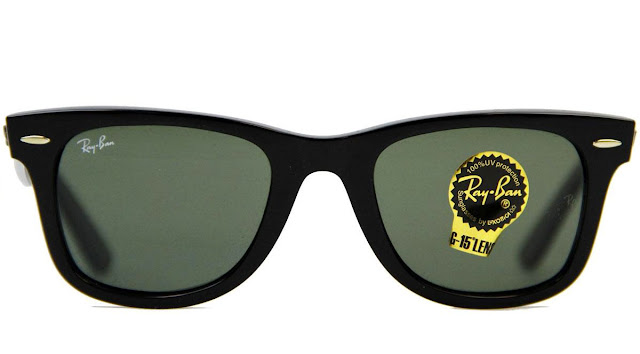"Built as strong and sturdy as the personalities that wore them..."
- The Wayfarer, Ray-Ban Icons
"It's 106 miles to Chicago, we got a full tank of gas, half a pack of cigarettes, it's dark... and we're wearing sunglasses."
- The Blues Brothers, 1980
Ray-Ban began selling the Wayfarer in 1956, the first of it's kind and a revolution in eyewear. It had been designed and patented in 1952 by American optical designer, Raymond Stegeman who procured lots of patents for Bausch & Lomb, Ray-Ban's parent company at the time.
The design was new and different from anything that had gone before in two respects - it was to utilise new plastic molding technology, marking a transition from wire and metal frame eyewear into plastic frame eyewear - something not available previously, and also it's intrinsic 1950s style, which reflected Atomic and Space age design and according to design critic Stephen Bayley, "Eames chairs and Cadillac tail fins."
The Wayfarer was instantly popular. James Dean wore Wayfarers in Rebel Without A Cause and the sunglasses became forever associated with rock and roll with everyone from Roy Orbison to John Lennon to Bob Dylan donning a pair throughout the fifties and sixties.
In the 1970s there was a decline in popularity for the Wayfarer as Aviator styles became popular on the disco scene. As unbelievable as it might seem, by the start of the 1980s the Wayfarer was on the verge of being discontinued by Ray-Ban.
However, the eighties was about to be a very good decade for the Wayfarer, further cementing this iconic style. Firstly the release of the cult classic comedy, The Blues Brothers, in 1980 - featuring Wayfarer sunglasses heavily. Creator (and star!) of The Blues Brothers, Dan Aykroyd, has remarked how the instantly recognisable image of Joliet Jake and Elwood Blues was inspired and based on an image of legendary blues artist, John Lee Hooker wearing black Wayfarers and a black pork pie trilby hat.
But the fortunes of the Wayfarer was really reversed when Ray-Ban signed a lucrative product placement deal for the sunglasses to be features in movies and TV shows in 1982. Between 1982 and 1987 Ray-Ban Wayfarers appeared in over 60 films and TV shows as part of this deal, but perhaps most famously they were donned in Risky Business (1983), The Breakfast Club (1985) and on TV shows Miami Vice and Moonlighting. After being worn by Tom Cruise in Risky Business, 360,000 pairs of Wayfarers were sold in 1983, in comparison to only 18,000 pairs being sold 2 years earlier in 1981, and by 1986 this had reached 1.5 million pair sold.
In reaction to this new demand, Ray-Ban expanded it's Wayfarer styles offer, from two up to 40 different Wayfarer styles offered in 1989.
In 2001, Ray-Ban designed the 'new' Wayfarer, giving the classic a contemporary update. The frames were made smaller and less angular, and the heavy acetate material was replaced with a lighter injected plastic frame, meaning the style was easier and more comfortable to wear. Additionally, as of 2007, Wayfarers are available in Original Wayfarer, New Wayfarer and Folding Wayfarer styles, as well as new colours and limited edition prints which are available every season.
Since the eighties, the Wayfarers popularity has dipped and risen again - the 90s saw a rise in the popularity of wrap round sunglasses, so Wayfarer fell out of fashion a little bit again - but one thing is certain, the Wayfarer is always cool. For instant cool, just add Wayfarers!
Find more Wayfarer Sunglasses here.
"It's 106 miles to Chicago, we got a full tank of gas, half a pack of cigarettes, it's dark... and we're wearing sunglasses."
- The Blues Brothers, 1980
The Ray-Ban Wayfarer, possibly the most famous, iconic and instantly recognisable sunglasses style in history, and it's easy to see why. The typically black, solid frame and green G-15 lens affords the wearer the desired amount of anonymity, privacy and... well, it just instantly adds cool to any look or outfit, doesn't it?!
 |
| The original patent , filed in 1952 |
The design was new and different from anything that had gone before in two respects - it was to utilise new plastic molding technology, marking a transition from wire and metal frame eyewear into plastic frame eyewear - something not available previously, and also it's intrinsic 1950s style, which reflected Atomic and Space age design and according to design critic Stephen Bayley, "Eames chairs and Cadillac tail fins."
 |
| James Dean wearing Wayfarer Sunglasses |
The Wayfarer was instantly popular. James Dean wore Wayfarers in Rebel Without A Cause and the sunglasses became forever associated with rock and roll with everyone from Roy Orbison to John Lennon to Bob Dylan donning a pair throughout the fifties and sixties.
 |
| John Lee Hooker |
However, the eighties was about to be a very good decade for the Wayfarer, further cementing this iconic style. Firstly the release of the cult classic comedy, The Blues Brothers, in 1980 - featuring Wayfarer sunglasses heavily. Creator (and star!) of The Blues Brothers, Dan Aykroyd, has remarked how the instantly recognisable image of Joliet Jake and Elwood Blues was inspired and based on an image of legendary blues artist, John Lee Hooker wearing black Wayfarers and a black pork pie trilby hat.
But the fortunes of the Wayfarer was really reversed when Ray-Ban signed a lucrative product placement deal for the sunglasses to be features in movies and TV shows in 1982. Between 1982 and 1987 Ray-Ban Wayfarers appeared in over 60 films and TV shows as part of this deal, but perhaps most famously they were donned in Risky Business (1983), The Breakfast Club (1985) and on TV shows Miami Vice and Moonlighting. After being worn by Tom Cruise in Risky Business, 360,000 pairs of Wayfarers were sold in 1983, in comparison to only 18,000 pairs being sold 2 years earlier in 1981, and by 1986 this had reached 1.5 million pair sold.
In reaction to this new demand, Ray-Ban expanded it's Wayfarer styles offer, from two up to 40 different Wayfarer styles offered in 1989.
In 2001, Ray-Ban designed the 'new' Wayfarer, giving the classic a contemporary update. The frames were made smaller and less angular, and the heavy acetate material was replaced with a lighter injected plastic frame, meaning the style was easier and more comfortable to wear. Additionally, as of 2007, Wayfarers are available in Original Wayfarer, New Wayfarer and Folding Wayfarer styles, as well as new colours and limited edition prints which are available every season.
Since the eighties, the Wayfarers popularity has dipped and risen again - the 90s saw a rise in the popularity of wrap round sunglasses, so Wayfarer fell out of fashion a little bit again - but one thing is certain, the Wayfarer is always cool. For instant cool, just add Wayfarers!
Find more Wayfarer Sunglasses here.

.png)








No comments:
Post a Comment